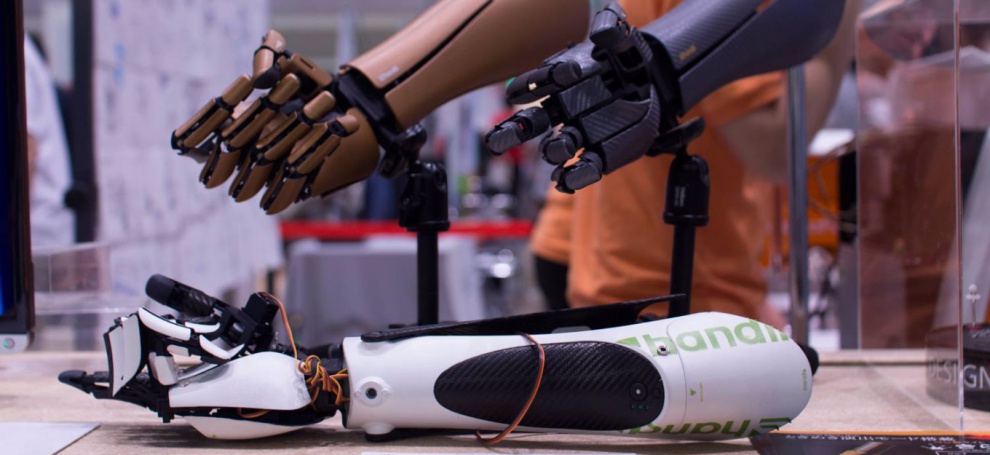How 3D Printing Changes Limb Prosthetics

Prosthetics is the most optimal way to solve the problem of a person having no limbs . With the advent of 3D printers , a new stage has begun in the development of prosthetics. The number of companies involved in the creation of 3D-printed limbs has increased several times. Read about the most interesting and promising of them in our review.
Össur
Since 1971, the company has been engaged in orthopedic equipment, as well as artificial limbs, which are sold in the American, European and Asian markets. In their new models, developers use technology to create the effect of the functioning of real human muscles. A special mechanism and materials running software can be adapted to walking. They also provide movement on complex surfaces with simultaneous acceleration and deceleration of steps to minimize costs with each step.
Touch bionics
Since 2007, a company from Scotland has been engaged in prosthetics of the upper limbs. Its main development is the myoelectric prosthesis of the hand, controlled by muscle contractions, as well as using the developed mobile application.
These prostheses are designed both for making complex movements, and for lifting objects of very small sizes. The settings of the prosthesis sensors allow the bionic fingers to take the position specified in the settings when moving the hand in any direction. It is also possible to control the force exerted by the fingers of the prosthesis to compress objects and the speed of the fingers.
Bionx
The company was founded in 2007 by Dr. Hugh Herr, who studied bionics and was involved in prosthetics of the lower extremities.
Herr is also among the developers who were looking for a way to first improve their livelihoods. A former climber, he lost both legs as a result of frostbite.
The developer is sure that the era of bionics is coming, in which we discover technologies that allow us to imitate important physiological functions.
Herr initiated the manufacture of a lower limb prosthesis BiOM, which is able to simulate muscle functions. It also allows you to apply the necessary effort while climbing up slopes or stairs, while maintaining smoothness and flexibility.
Standard cyborg
The founding father of this company is Jeff Huber. And her story began with the fact that an engineer and entrepreneur bought 3D equipment worth $ 1 thousand for the manufacture of ready-made test models. The start was successful, and Standard Cyborg joined the Y Combinator accelerator.
Jeff himself in childhood as a result of illness lost part of his left leg. Therefore, he knows firsthand about the high cost of prostheses, especially for people who have come of age.
Huber initially paid more attention to prosthetics of the part of the leg below the knee. This choice was due to the fact that even in expensive prostheses, water, sand and other dirt get into this area. Avoiding this is difficult. For example, showering on one leg is almost impossible. To solve the problem, Jeff began developing budgetary artificial limbs with protection against water and dirt.
The engineer scanned an expensive prosthesis with protection against water and printed it using three-dimensional equipment. The printed prosthesis is equipped with a unique protective layer of carbon fiber. This prosthesis is not so flexible, but it can be bought for $ 800.
Exiii
The company was founded in 2014 by three friends who at one time worked for Sony and Panasonic. The ideological inspirer of the project was Gent Condo, who eventually became the CEO of the company. As an employee of Sony, since 2011 he studied bionic prostheses and the motility of the human body. But only with the advent of low-cost 3D equipment last year, he began to realize his idea.
Kondo examined the Japanese market for prosthetic limbs and found that the niche was still empty. Only a small part of people prefer functional prostheses, while most use cosmetic substitutes.
Genta Condo is confident that 3D printers will have an impact on many industries around the world, and he proves this with his achievements.
The first prototype of the bionic arm allowed him to become the owner of the second place in one of the contests, then the ExXi prototypes were seen by the guests of the SXSW festival.
Today, Exiii designs include five models. The last of them uses three motors that ensure the functioning of the fingers. To work, you need to recharge the power supply from a digital camera weighing 650 g. All bioelectric prototypes are based on technology that converts muscle contractions into motorized finger movements.
Recently, Exiii decided to open access to software sources and part models suitable for playback on a 3D printer. Thus, the company invites enthusiasts from all over the world to assist in the development of developments.
Bebionic
One of the Steeper divisions specializes in hand prosthetics. Its main product is microprocessor controlled. The actuation of each finger of the prosthesis is performed using a separate motor, which is controlled by software.
The system has fourteen specially selected options for the positions of the fingers and four for the brush.
The load that the structure can withstand reaches forty-five kilograms. The mini version of the prosthesis - bebionic small - is ideal for women.
Open bionics
A startup from Britain is developing low-cost myoelectric hand prostheses. The price of their products is more affordable than that of competitors. But low cost does not affect its quality and functions. Open Bionics developments can be found in the public domain. In addition, the company is a member of the Disney accelerator, making children's prostheses. The company's products should appear on the market next year.
